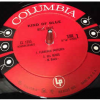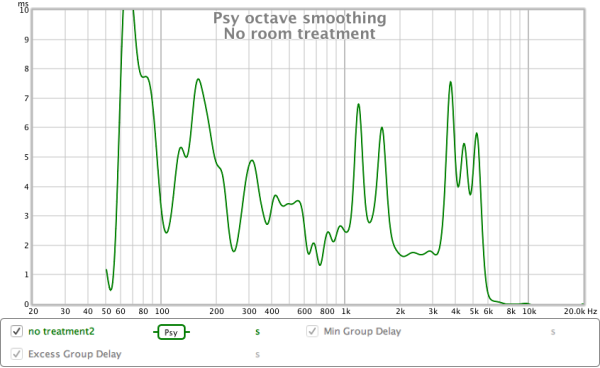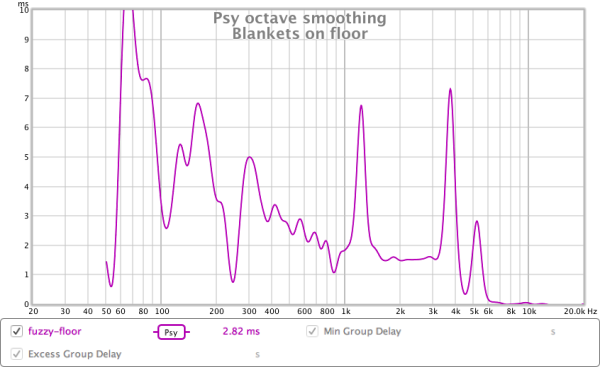-
Posts
655 -
Joined
-
Last visited
Content Type
Forums
Events
Gallery
Everything posted by pbphoto
-
Have you compared the two? I'd be interested in your impressions.
-

Fastrac Horns/A-55G midranges in La Scala II's
pbphoto replied to ozolius's topic in Technical/Restorations
I have the LS2's as well and replaced the K77's with CT120s. Swapped them back and forth about 6 times over the last year until I got it right using the stock crossover. The CT120 is a nice smooth clear tweeter but it runs hot above 8khz on the LS2 unless you attenuate it a bit. I tried many methods to tamp it down but settled on strips of felt tape that cover about 50% of the CT120 horn throat and lens. This makes the CT120 about 2db softer than the K77 from 6-8khz (the sibilance range) and then about 2db louder than the K77 above 8khz. I like the sound. Crisp without fatigue. So far, I've left the midrange stock. It can get shouty at loud volumes but I think this mostly due to the sound bouncing around my room rather than the squawker or K401 horn itself. Let me know what you find with the A55-G. -
I always suspected my room had a few early reflections but struggled to accurately measure them. Several times, my La Scala 2's ended up surrounded by pillows and blankets like No'4's photo above, but my impulse and RT60 graphs didn't significantly change. I thought maybe I could hear a difference but it could have been a placebo. However, the excessive group delay graph has helped me now - thanks Chris! What I learned is even though I have a carpeted floor with padding over a concrete slab, it is the source of a significant amount of early reflections. It's a commercial carpet with low loop pile. Layering a blanket or pillow over the carpet in front of the speaker really improved my group-delay graph. Outside of this, I took a lot of measurements with pillows and blankets everywhere, and the other major reflection point I found was the back wall about 18 feet away. Charts below. All measurements left speaker only, 1 meter. I'll work on the right speaker next. Excess group delay: no room treatment Excess group delay: blankets on floor Excess group delay: blankets on floor and rear wall RT60 with blankets on floor and rear wall
-
Beautiful! IMHO, more important than bi-wiring and speaker cables, is your source. I would think the Yamaha built-in DAC is a step up from the one inside your MacBook Pro, so be sure to use a digital (toslink optical) wire from your MBP to the Yamaha. Or plug in a Dragonfly USB DAC to your MBP and then analog RCA cables to the Yamaha. Invest your money here rather than on cables.
-
Yes, the RX-V583 is rated at 80W per channel @ 2-channels driven, probably much much less @ 7-channels driven, but still plenty to power a Klipsch center channel. Note your RP-450C is worth more than your Yamaha, so at some point you will want to upgrade. But since you already own it, give the RX-V583 a shot.
- 1 reply
-
- 1
-

-

The best 'source' for music? Download 24 bit? Vinyl? Or ?
pbphoto replied to 32blownhemi's topic in 2-Channel Home Audio
Interesting video. Is it saying that if we watched our music on a computer screen, we could tell that vinyl was superior to a CD because it has stuff above 22Khz? I'll have to ask my cats if they enjoy the vinyl version more than the CD version. My old ears certainly can't hear anything up there. Now if the video made the argument that, given the identical source material, playback on vinyl sounds different, and subjectively better, than playback on CD, I'll go for that. But even so, back to the OP's original question, I'd go for the best source material first and worry about the medium second. -

The best 'source' for music? Download 24 bit? Vinyl? Or ?
pbphoto replied to 32blownhemi's topic in 2-Channel Home Audio
Agree 100%. Some artists and/or engineers put much more effort into producing a great source product - especially if it's advertised as an all-analog AAA or hi-res digital project. For music that's important to you, it's worth checking hdtracks vs iTunes vs vinyl to see if there is a difference in the source material, not because one medium is better than another. For me, it's tough to beat the convenience and quality of iTunes for most of my stuff. However, I do have hi-res and vinyl for stuff that is special to me. -

KG 3.2 Scratchy Horn - Miles Davis "So What"
pbphoto replied to Joe Ramsey's topic in Technical/Restorations
Switch the speaker cables and replay the song, Does the static follow the cables or stay with the right speaker? When I listen to So What with headphones, during the opening few notes, the trumpet has some spittle (right track) and the sax has some scratchiness (left channel.) Your KG 3.2's might just be revealing what's in the original recording. -

Klipsch Rp-260F & Pioneer vsx-921 need to crank the volume up?
pbphoto replied to Spirit_Rises's topic in Home Theater
Sounds like you want somebody to tell you that you need a new AVR? Maybe so, but if you were happy with the Pioneer driving your Jamo's, then you should be very happy with the Pioneer driving the Klipsch. Temporarily turn off MCACC to simplify things while you get 2-channel dialed in, then go back and configure your home theater. Right now, you have too many variables at play. Based on the picture, I would move the klipsch inward towards the TV (further away from the side walls) and forward so they are slightly in front of the TV stand. Then toe them inward a little bit to start and adjust to your preference. -

Stereo, Pure and Direct, Where is it at?
pbphoto replied to derrickdj1's topic in 2-Channel Home Audio
"Pure Direct" and "Direct" are more marketing terms. Every manufacturer has a different take. Some allow a subwoofer to be added when using Pure Direct via an 'extra bass', 'double bass', or 'LFE+Main' setting. Most manufacturers still digitize the signal even in 'Pure Direct' mode; the signal still goes through an A-->D and D-->A conversion but it bypasses the DSP stuff. A few manufacturers allow for a pure analog path in their AVRs and usually advertise it clearly - Anthem, Arcam, and I've heard rumors that some Marantz AVRs allow a pure analog signal via certain analog-in ports. IMHO, if you want to guarantee a pure analog signal path from your TT or expensive DAC to your speakers, then go buy an integrated amp from the 1970s. Now, whether or not this is even important or noticeable today is a different matter. -

Klipsch Rp-260F & Pioneer vsx-921 need to crank the volume up?
pbphoto replied to Spirit_Rises's topic in Home Theater
Yes, IMHO your AVR has enough power for the Klipsch, which are 5db more efficient than the Jamo. When you hooked up the Klipsch, did you make any changes to the settings on the AVR or re-run some sort of calibration with a microphone? -

Stereo, Pure and Direct, Where is it at?
pbphoto replied to derrickdj1's topic in 2-Channel Home Audio
I use a 16 year old low-end Yamaha AVR with an external amp for both 2-channel and movies. It just won't die. There is no pure-direct on this old model but I do have it set to 'effect off' that, best as I can tell, still digitizes the 2-channel signal but doesn't add any processing to it. Bass is configured in the old-school "double bass" method where the mains are set to 'large' and bass below 120hz is also duplicated to the sub and feathered-in with the mains via controls on the sub. Many say this is wrong nowadays, but it sounds damn good. I've done two experiments where I've setup my source to bypass the Yamaha via a passive A/B switch, and in both cases, neither me or my teenage kids with good ears have been able to tell a difference in sound going through the AVR versus bypassing the AVR and going directly to the amp. I'm considering a 2017 Yamaha AVR or Pre-pro and changing my 2-channel setup to a more modern approach: speakers set to 'small', subwoofer controlled by the AVR crossover, YPAO room correction etc. -

Klipsch Rp-260F & Pioneer vsx-921 need to crank the volume up?
pbphoto replied to Spirit_Rises's topic in Home Theater
That's the big question. Not sure. What model Jamo's do you have? Did any settings change on the AVR when you connected the new Klipsch and moved the Jamo's to the rears? -

Klipsch Rp-260F & Pioneer vsx-921 need to crank the volume up?
pbphoto replied to Spirit_Rises's topic in Home Theater
The Klipsch should play louder than the Jamo's, all else being equal. I'm not familiar with that particular AVR, but the stats show 80W per channel for 2-channel, probably much less for 7.1. If the Pioneer had enough power for the Jamo's then it should have plenty for the Klipsch. -

Klipsch Rp-260F & Pioneer vsx-921 need to crank the volume up?
pbphoto replied to Spirit_Rises's topic in Home Theater
I would expect the opposite. Because Klipsch speakers have higher efficiency than most, cranking up the volume knob usually isn't necessary. Your RP-260F's have a 97 sensitivity. What speakers are you coming from and were you running them on the same VSX-921? Or is this a whole new system? -
If you are using an IPAD and don't mind a wired connection, then do what jimjimbo said: iPAD --> usb --> dragonfly --> RCA cable --> integrated amp. If you want wireless, use Airplay built-in to the iPAD and stream to an Apple Airport: iPAD --> Airplay --> Airport --> RCA cable --> integrated amp. Or if you really want to get fancy: IPAD --> Airplay --> Airport --> toslink --> DAC --> RCA cable --> integrated amp. This would be a step up from the built-in Airport DAC. Airplay is "limited" to bit-perfect CD quality 44.1/16. That's about the best I can hear. In theory, a direct wired connection is superior because it allows you to directly control the DAC at high-res / upsample beyond 44.1/16, but we're getting into splitting hairs here. There are other proprietary hi-res wifi technologies, but that's a whole other matter.
-
well said. agree 100% although I feel a little cave-man-ish after reading this because I just finished listening to an LP. I'm going to retreat to my safe-space now.
-

Heresy III How to get the best sound out of Heresy III
pbphoto replied to Lud Mil's topic in 2-Channel Home Audio
There are some Rube Goldberg methods to get an iPAD connected via USB to a DAC without going through the iPAD's internal DAC, aka digital-out. That last part is key. Do a google search on "iPAD digital out." Here's an example: http://blog.jdslabs.com/?p=838 This is much easier on a full-blown MacBook Pro (hardwired) or an Airport Express (via Airplay) because they have a combo analog/optical-digital headphone jack. -

Heresy III How to get the best sound out of Heresy III
pbphoto replied to Lud Mil's topic in 2-Channel Home Audio
Just brainstorming here. Invest in a simple high-quality integrated amp and then get an external streaming device like an Airport Express feeding an external DAC to add the convenience of wifi. Although it looks like most of the sub-$1K integrated amps include a built-in DAC and optional blue-tooth, so you might as well use it to start. wifi streaming has better quality although the newest blue-tooth apt-x is pretty decent. If you use iTunes, I would get a Yamaha A-S701, Airport Express, and an optical toslink cable and call it a day. You can stream Pandora over Airplay. Add an external DAC down the road. -
For a reason. If you are worried about amp tube maintenance then I wouldn't go down the path of getting cheap H1's or H2's and trying to upgrade them. Hold out for a nice set of gently used H3's and all the work has been done for you. my .02
-
Used Heresy 3's should be around $1K-ish depending on age, finish and condition. Very nice highs and mids with taught bass down to 50-60hz depending on room placement. Spend the rest on a nice 2-channel amp and cd player.
-
Excellent well thought-out decision IMHO. Please let us know how it works out - especially the SQ with/without YPAO. I'm not far behind you - my 16 year Yamaha just won't die on me but I've been itching to upgrade with many of the same criteria as you.
-
+1 to what Garyrc said. Make sure your Yamaha is setup properly before returning it. Specifically, front speakers set to LARGE and try straight or pure-direct mode since you don't have a sub. Also check your Blueray player - if you are connected via HDMI or COAX, make sure it's sending 2-channel audio, not multi-channel to speakers that don't exist. One simple test would be to 1) make sure the AVR has the front speakers set to large and then 2) play some 2-channel music via bluetooth or Airplay and see how it sounds.
-
You have the foundation for a very nice system. Is the RX-V681 new as well? What don't you like about the sound you are hearing? Does "big sound" mean loud or lots of bass, or both? Is there a sub or other multi-channel speakers in the mix here? Describe your room too. Give us some more details and we'll see if we can sort this out. Without knowing anything about your particular situation, but seeing several of these scenarios come through the forum in recent months, I'd bet there is an 'unintended setting' on the Yamaha in play here: speakers set to "small", YPAO doing something goofy, pure-direct mode disabling the sub etc...





